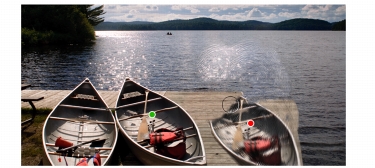
Quick links to procedures on this page:
• |
• |
• |
Offset sampling, also known as “point-to-point cloning,” lets you sample an area of an image and then reuse it elsewhere within the document, or in separate document. Sampling is a useful technique for retouching photographs.
To perform offset sampling, you must set a sampling reference point and then set destination reference points. Sampling reference points specify the area of the document that you want to reuse, or clone. Destination reference points determine the area where you want the sampled image to appear. To identify which area of the source document you are sampling, you can turn the crosshairs cursor on.

The green dot (left) represents the sampling reference point. The red dot (right) represents the destination point.
It is important to note that the sampling reference point, also know as the source, is not treated as a clone source. The sampled area does not display in the Clone Source panel.
| To perform offset sampling within a document |
1 |
Click the Rubber Stamp tool |
If you want to adjust the size of the sampled area, type a value in the Size box, or adjust the slider on the property bar. |
2 |
Hold down Option (Mac OS) or Alt (Windows), and click to set the source
reference point.
|
A green marker appears on the image, indicating the reference point for the source image. |
3 |
Hold down Option + Shift (Mac OS) or Alt + Shift (Windows), and click to set
the destination reference point.
|
4 |
Apply brushstrokes to the destination area to reveal the sampled area.
|
You can disable offset sampling by clicking the Clone Color button in the Color panel or by clicking the Brush Selector on the Brush Selector bar, and choosing a non-Cloner brush variant. |
You can also enable offset sampling by clicking the Cloner tool |
You can set the destination area before painting by clicking while holding
down Option + Shift (Mac OS) or Alt + Shift (Windows). A red marker
indicates the destination area.
|
| To perform offset sampling between documents |
1 |
Open both the image that you want to use as the sampling source and the image
that you want to use as the destination.
|
If you want to view both images at once, you may want to arrange the images side-by-side. |
2 |
With the source image selected, click the Cloner tool |
If you want to change the brush variant, click the Brush Selector, and click a Cloners brush variant in the Brush Library panel. |
3 |
Hold down Option (Mac OS) or Alt (Windows), and click the source document to
set the sample source area reference point.
|
A green numbered marker appears on the image to indicate the reference point for the source area. |
4 |
Hold down Option + Shift (Mac OS) or Alt + Shift (Windows), and click the
destination document to set the destination reference point.
|
5 |
In destination document, apply brushstrokes to the canvas.
|
You can disable offset sampling by clicking the Clone Color button in the Color panel or by clicking the Brush Selector on the Brush Selector bar, and choosing a non-Cloner brush variant. |
| To change to the crosshair cursor for sampling |
1 |
Do one of the following:
|
• |
(Mac OS) Choose Corel Painter 12 |
• |
(Windows) Choose Edit |
2 |
In the Preferences dialog box, enable the Display Crosshairs To Identify Rubber
Stamp Sampling Source option.
|
The crosshairs indicate which area of the original image you’re sampling as you paint. |
|
|
Copyright 2012 Corel Corporation. All rights reserved.